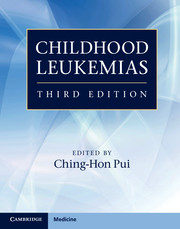Book contents
- Frontmatter
- Contents
- List of contributors
- Preface
- Section 1 History and general issues
- Section 2 Cell biology and pathobiology
- 4 Immunophenotyping
- 5 Immunoglobulin and T-cell receptor gene rearrangements
- 6 Cytogenetics of acute leukemias
- 7 Molecular genetics of acute lymphoblastic leukemia
- 8 Molecular genetics of acute myeloid leukemia
- 9 Epigenetics of leukemia
- 10 Genetics and cellular drug resistance in acute leukemia
- 11 Heritable predisposition to childhood hematologic malignancies
- Section 3 Evaluation and treatment
- Section 4 Complications and supportive care
- Index
- Plate Section
- References
7 - Molecular genetics of acute lymphoblastic leukemia
from Section 2 - Cell biology and pathobiology
Published online by Cambridge University Press: 05 April 2013
- Frontmatter
- Contents
- List of contributors
- Preface
- Section 1 History and general issues
- Section 2 Cell biology and pathobiology
- 4 Immunophenotyping
- 5 Immunoglobulin and T-cell receptor gene rearrangements
- 6 Cytogenetics of acute leukemias
- 7 Molecular genetics of acute lymphoblastic leukemia
- 8 Molecular genetics of acute myeloid leukemia
- 9 Epigenetics of leukemia
- 10 Genetics and cellular drug resistance in acute leukemia
- 11 Heritable predisposition to childhood hematologic malignancies
- Section 3 Evaluation and treatment
- Section 4 Complications and supportive care
- Index
- Plate Section
- References
Summary
Introduction
The majority of cases of acute lymphoblastic leukemia (ALL) are known to have a genetic basis. Most leukemic cells harbor gross chromosomal alterations that have key roles in initiating leukemogenesis. These alterations include gains and losses of whole chromosomes (hyper- and hypodiploidy), and structural alterations including translocations, inversions, deletions, and amplifications. Identification, cloning, and functional analysis of genes disrupted or rearranged by these alterations has led to characterization of numerous oncogenes and tumor suppressors with key roles in leukemogenesis. Detection of these alterations by cytogenetic techniques (karyotyping or fluorescence in situ hybridization [FISH]) and molecular analyses is extensively used in diagnosis and risk stratification in order to assign appropriate treatment. While the importance of these gross chromosomal alterations in leukemogenesis has been known for many years, it has also been long recognized that many of the chromosomal alterations are insufficient to cause leukemia in experimental models, or may be detected many years prior to the clinical onset of leukemia. Moreover, a substantial minority of children (and a higher proportion of adults) lack a gross chromosomal alteration on cytogenetic analysis. Together, these findings indicate that additional submicroscopic genetic alterations also contribute to leukemogenesis. With the advent of technology to interrogate genome-wide changes in DNA copy number (i.e., amplifications and deletions) at very high resolution, and to identify sequence mutations in a high-throughput manner, it has become clear that ALL genomes commonly harbor both gross and submicroscopic genetic alterations. These alterations commonly involve genes that regulate lymphoid development, cell cycle, tumor suppression, and a variety of other key cellular pathways, and emerging data indicate that many of these alterations influence leukemogenesis and treatment responsiveness.
- Type
- Chapter
- Information
- Childhood Leukemias , pp. 168 - 203Publisher: Cambridge University PressPrint publication year: 2012
References
- 2
- Cited by



